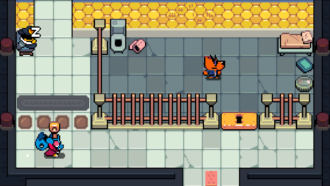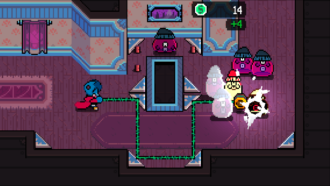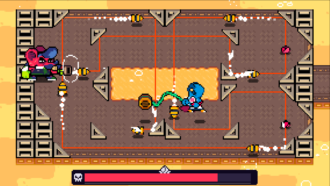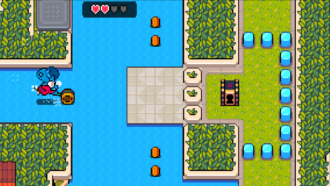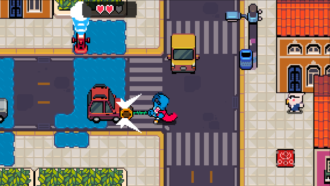Platforms:
PC, Nintendo Switch, PS5, Xbox Series X|S
Released:
May 28, 2025
Publisher:
PM Studios
Developer:
Pocket Trap
They’re calling it the world’s first Yoyovania, and it’s here on the completely non-copyright infringing Pocket Trap Game System ™. Pipistrello and the Cursed Yoyo is a top-down 2D adventure game, but also a love letter to the era of Game Boy Advance portable gaming. It’s got gorgeous design and a whole lot of charm, but does it have enough tricks to make it to the big time?
You play as the titular Pipistrello, nephew to a powerful energy tycoon. After discovering new, world-changing electricity sources, your aunt has a full monopoly over New Jolt City and charges exorbitant prices for her company’s services. You don’t care about any of that, though – you’re just visiting her to ask for some money to continue on your yo-yo-ing adventures.
But that all changes when she’s attacked by four disgruntled former business partners, and her soul inadvertently gets trapped inside your yo-yo. You have to recover the four mega-batteries to get your aunt’s body back, and maybe teach her something about unethical monopolies along the way.

A metroidvania game like this relies heavily on its environments, and this is one area in which Pipistrello and the Cursed Yoyo shines. New Jolt City is a charming location, filled with puzzle rooms, secrets to uncover, sewers to explore, and side quests to complete. There’s a quirky, tongue-in-cheek vibe present through the design of the whole game, and exploring feels worthwhile and exciting.
The game is heavily inspired by classic top-down Zelda-style adventures, and especially the experience of playing them on old handheld consoles. Pocket Trap wants to help you capture that nostalgic feeling, to the point where if you’re playing on a big screen and want to capture that feeling, you can turn on a virtual handheld console that holds the game in the middle.
Unfortunately, the core combat loop of Pipistrello is the weakest element of the whole game. The whole thing plays a little bit like an old-school beat-em-up, as you run and jump around the screen to avoid enemy attacks. Your main attack is to shoot out your yo-yo, which on its own doesn’t go super far – but throw it at an angled corner, and it will bounce around, extending your reach and hitting enemies you otherwise couldn’t get.
It’s a really solid idea, but in practice, it feels stilted and clunky. You don’t move very fast, your hit box is pretty sizeable, and enemies move with decent speed. That combination means you spend far more time jumping around than actually being able to attack. It’s especially noticeable when you’re dumped in a room with no corners to bounce off, which happened more often than I expected. It feels retro, for sure, but not in a particularly fun way.
“…the core loop never really hits full throttle.”
This does get significantly better as you progress and unlock more abilities and attacks, like the ability to parry projectiles or to run across the screen. Some of the badges you collect (more on that later) can dramatically change how the core combat feels, and by the time you’re messing around with moves and abilities, it feels far more fluid. But the core loop never really hits full throttle.
Thankfully, there’s a pretty robust difficulty menu that allows you to fine-tune the game’s balance to suit your playstyle. Every time I see a menu like this, I feel it’s worth shouting out, especially since the baseline difficulty makes the combat feel much worse. At any point, you can change how much damage you deal or receive, how many lives you have, and even the underlying game speed. Messing around with these a bit counteracted my larger frustrations with the combat.
Something that Pipistrello really shines at, though, is the upgrade system. Early on, you’ll unlock the ability to progress through a pretty standard upgrade tree, but the merchant is a germaphobe – and won’t accept any of the money you’ve already collected. Instead, to buy an upgrade, you have to go into debt for it. You receive the upgrade immediately, but also a negative effect until you’ve paid it off, like losing maximum health, or enemies not dropping hearts. Then, 50% of the money you collect goes to paying off your new purchase.
“…if you can find a way into the combat, there’s a whole lot to like…”
It feels fantastic. There’s a twofold effect where, on one hand, you’re never locked out of progressing through the upgrades, but on the other hand, you have to survive the negative effects to finish paying them off. You get that sense of always getting stronger, with the added push and pull of weighing up what risks you’re happy to take right now.
There are also badges that you unlock throughout the game, usually by completing side quests or puzzle rooms. These can dramatically alter how the game feels, like greatly increasing the damage your yo-yo does, but making it much slower. Each badge has a point cost, and you can only have a certain number of points allocated at once, which you can increase through the upgrade tree.
So if you can find a way into the combat, there’s a whole lot to like about Pipistrello. It can still be frustrating, but once you get a couple of hours in, there’s way more happening to keep you engaged. The progression curve is handled really well, and the puzzles start requiring you to chain moves together in some really fun ways. I’d still recommend it to anyone looking for an experience like this, but it’s a recommendation with a caveat.
7
Good
Positive:
- A love letter to retro handheld gaming
- A fantastic and inventive upgrade system
- Great sense of progression
- Customisable difficulty levels allow you to craft your own experience
Negative:
- The core combat feels clunky and a bit dated
- Takes a while to find a good rhythm
- Baseline difficulty makes for a frustrating experience
While the core gameplay loop of Pipistrello and the Cursed Yoyo feels dated, there’s a lot to enjoy in the retro-inspired experience that Pocket Trap have crafted. The level design and puzzles, badge and upgrade system, and art design make it worth a look if you’re craving an old-school adventure. There’s a great game in here, but it’s sometimes held back from shining through.
